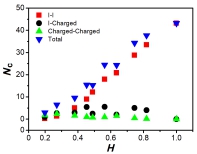-
[1]
Kister, A. E.; Potapov, V. Biochem. Soc. Trans. 2013, 41, 616.
doi: 10.1042/BST20120308
-
[2]
Sadowski, M. I.; Jones, D. T. Curr. Opin. Struct. Biol. 2009, 19, 357.
doi: 10.1016/j.sbi.2009.03.008
-
[3]
Shenoy, S. R.; Jayaram, B. Curr. Protein Pept. Sci. 2010, 11, 498.
doi: 10.2174/138920310794109094
-
[4]
Chu, X.; Gan, L.; Wang, E.; Wang, J. Proc. Natl. Acad. Sci. U. S. A. 2013, 110, E2342.
doi: 10.1073/pnas.1220699110
-
[5]
Daggett, V.; Fersht, A. Nat. Rev. Mol. Cell Biol. 2003, 4, 497.
doi: 10.1038/nrm1126
-
[6]
Daggett, V.; Fersht, A. R. Trends Biochem. Sci. 2003, 28, 18.
doi: 10.1016/S0968-0004(02)00012-9
-
[7]
Dinner, A. R.; Sali, A.; Smith, L. J.; Dobson, C. M.; Karplus, M. Trends Biochem. Sci. 2000, 25, 331.
doi: 10.1016/S0968-0004(00)01610-8
-
[8]
Leelananda, S. P.; Jernigan, R. L.; Kloczkowski, A. J. Comput. Biol. 2016, 23, 400.
doi: 10.1089/cmb.2015.0209
-
[9]
Li, H.; Helling, R.; Tang, C.; Wingreen, N. Science 1996, 273, 666.
doi: 10.1126/science.273.5275.666
-
[10]
Matouschek, A.; Serrano, L.; Fersht, A. R. J. Mol. Biol. 1992, 224, 819.
doi: 10.1016/0022-2836(92)90564-Z
-
[11]
Onuchic, J. N.; Luthey-Schulten, Z.; Wolynes, P. G. Annu. Rev. Phys. Chem. 1997, 48, 545.
doi: 10.1146/annurev.physchem.48.1.545
-
[12]
Schug, A.; Onuchic, J. N. Curr. Opin. Pharmacol. 2010, 10, 709.
doi: 10.1016/j.coph.2010.09.012
-
[13]
Wang, J.; Wang, W. Nat. Struct. Biol. 1999, 6, 1033.
doi: 10.1038/14918
-
[14]
Wang, J.; Wang, W. Adv. Phys. X 2016, 1, 444.
-
[15]
Wolynes, P. G. Biochimie 2015, 119, 218.
doi: 10.1016/j.biochi.2014.12.007
-
[16]
Apicella, A.; Marascio, M.; Colangelo, V.; Soncini, M.; Gautieri, A.; Plummer, C. J. J. Biomol. Struct. Dyn. 2017, 35, 1813.
doi: 10.1080/07391102.2016.1196151
-
[17]
Dyson, H. J.; Wright, P. E. Nat. Rev. Mol. Cell Biol. 2005, 6, 197.
doi: 10.1038/nrm1589
-
[18]
Gao, M.; Yang, F.; Zhang, L.; Su, Z.; Huang, Y. J. Biomol. Struct. Dyn. 2018, 36, 1171.
doi: 10.1080/07391102.2017.1316519
-
[19]
Jain, A.; Ashbaugh, H. S. J. Chem. Phys. 2008, 129, 174505.
doi: 10.1063/1.3003577
-
[20]
Kang, W. B.; He, C.; Liu, Z. X.; Wang, J.; Wang, W. J. Biomol. Struct. Dyn. 2019, 37 1956.
doi: 10.1080/07391102.2018.1472669
-
[21]
Khan, S. H.; Jasuja, R.; Kumar, R. J. Biomol. Struct. Dyn. 2017, 35, 2248.
doi: 10.1080/07391102.2016.1214086
-
[22]
Migliaccio, A. R.; Uversky, V. N. J. Biomol. Struct. Dyn. 2018, 36, 1617.
doi: 10.1080/07391102.2017.1330224
-
[23]
Oldfield, C. J.; Dunker, A. K. Annu. Rev. Biochem. 2014, 83, 553.
doi: 10.1146/annurev-biochem-072711-164947
-
[24]
Singh, I.; Singh, S.; Uversky, V. N.; Chandra, R. J. Biomol. Struct. Dyn. 2017, 1.
-
[25]
Uversky, V. N.; Oldfield, C. J.; Dunker, A. K. Annu. Rev. Biophys. 2008, 37, 215.
doi: 10.1146/annurev.biophys.37.032807.125924
-
[26]
Yacoub, H. A.; Al-Maghrabi, O. A.; Ahmed, E. S.; Uversky, V. N. J. Biomol. Struct. Dyn. 2017, 35, 836.
doi: 10.1080/07391102.2016.1164077
-
[27]
Uversky, V. N. Protein Sci. 2002, 11, 739.
doi: 10.1110/ps.4210102
-
[28]
Uversky, V. N.; Gillespie, J. R.; Fink, A. L. Proteins 2000, 41, 415.
doi: 10.1002/1097-0134(20001115)41:3<415::AID-PROT130>3.0.CO;2-7
-
[29]
Das, R. K.; Pappu, R. V. Proc. Natl. Acad. Sci. U. S. A. 2013, 110, 13392.
doi: 10.1073/pnas.1304749110
-
[30]
Mao, A. H.; Crick, S. L.; Vitalis, A.; Chicoine, C. L.; Pappu, R. V. Proc. Natl. Acad. Sci. U. S. A. 2010, 107, 8183.
doi: 10.1073/pnas.0911107107
-
[31]
Kang, W. B.; Wang, J.; Wang, W. Acta Phys. Sin. 2018, 67, 058701.
-
[32]
Yue, K.; Dill, K. A. Proc. Natl. Acad. Sci. U. S. A. 1995, 92, 146.
doi: 10.1073/pnas.92.1.146
-
[33]
Ashbaugh, H. S.; Asthagiri, D. J. Chem. Phys. 2008, 129, 204501.
-
[34]
Ashbaugh, H. S.; Hatch, H. W. J. Am. Chem. Soc. 2008, 130, 9536.
doi: 10.1021/ja802124e
-
[35]
Vitalis, A.; Pappu, R. V. J. Comput. Chem. 2009, 30, 673.
doi: 10.1002/jcc.21005
-
[36]
Vitalis, A.; Pappu, R. V. Annu. Rep. Comput. Chem. 2009, 5, 49.
doi: 10.1016/S1574-1400(09)00503-9
-
[37]
Jiang, P.; Yasar, F.; Hansmann, U. H. J. Chem. Theory Comput. 2013, 9, 3816.
doi: 10.1021/ct400312d
-
[38]
Mitsutake, A.; Okamoto, Y. Phys. Rev. E Stat. Nonlin Soft Matter Phys. 2009, 79, 047701.
doi: 10.1103/PhysRevE.79.047701
-
[39]
Nanias, M.; Czaplewski, C.; Scheraga, H. A. J. Chem. Theory Comput. 2006, 2, 513.
doi: 10.1021/ct050253o
-
[40]
Yoda, T.; Sugita, Y.; Okamoto, Y. Proteins 2007, 66, 846.
-
[41]
Kyte, J.; Doolittle, R. F. J. Mol. Biol. 1982, 157, 105.
doi: 10.1016/0022-2836(82)90515-0
-
[42]
Das, R. K.; Crick, S. L.; Pappu, R. V. J. Mol. Biol. 2012, 416, 287.
doi: 10.1016/j.jmb.2011.12.043
-
[43]
Pappu, R. V.; Wang, X.; Vitalis, A.; Crick, S. L. Arch. Biochem. Biophys. 2008, 469, 132.
doi: 10.1016/j.abb.2007.08.033
-
[44]
Jin, F.; Liu, Z. R.; Biophys. J. 2013, 104, 488.
doi: 10.1016/j.bpj.2012.12.012
-
[45]
Ruff, K. M.; Pappu, R. V.; Holehouse, A. S. Curr. Opin. Struct. Biol. 2019, 56, 1.
-
[46]
Choi, J. M.; Dar, F.; Pappu, R. V. PLOS Comp. Biol. 2019, 15, e1007028.
doi: 10.1371/journal.pcbi.1007028
-
[47]
Zhou, H. X.; Nguemaha, V.; Mazarakos, K.; Qin, S. B. Trends Biochem. Sci. 2018, 43, 499.
doi: 10.1016/j.tibs.2018.03.007
-
[48]
Dignon, G. L.; Zheng, W. W.; Best, R. B.; Kim, Y. C.; Mittal, J. Proc. Natl. Acad. Sci. U. S. A. 2018, 115, 9929.
doi: 10.1073/pnas.1804177115
-
[49]
Uversky, V. N. Curr. Opin. Struc. Biol. 2017, 44, 18.
doi: 10.1016/j.sbi.2016.10.015
-
[50]
Zhang, P. C.; Fang, W. Y.; Bao, L.; Kang, W. B. Acta Phys. Sin. 2020, 69, 138701(in Chinese).
-
[51]
Wang, G. C.; Cui, Y. B.; Sun, Y. H.; Zhong, B. Acta Chim. Sinica 1998, 56, 867(in Chinese).
-
[52]
Cao, D. P.; Wang, W. C.; Duan, X.; Jiao, Q. Z. Acta Chim. Sinica 2001, 59, 297(in Chinese).
-
[53]
Wang, D. C. Protein Engineering, Vol. 1, Chemical Industry Press, Beijing, 2008, p. 65(in Chinese).
-
[54]
Deng, H. Y.; Jia, Y.; Zhang, Y Acta Phys. Sin. 2016, 65, 178701(in Chinese).

 Login In
Login In







 DownLoad:
DownLoad:




